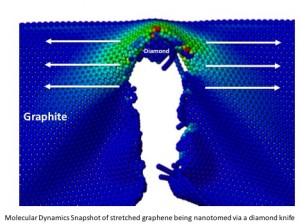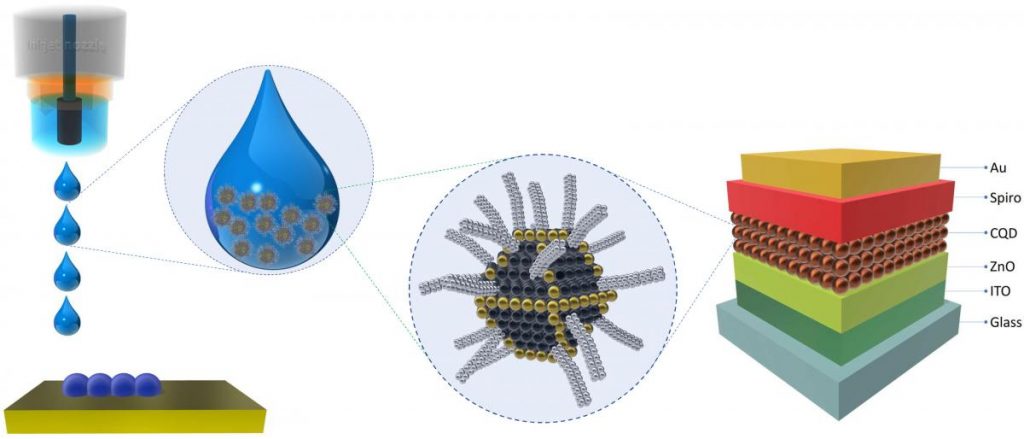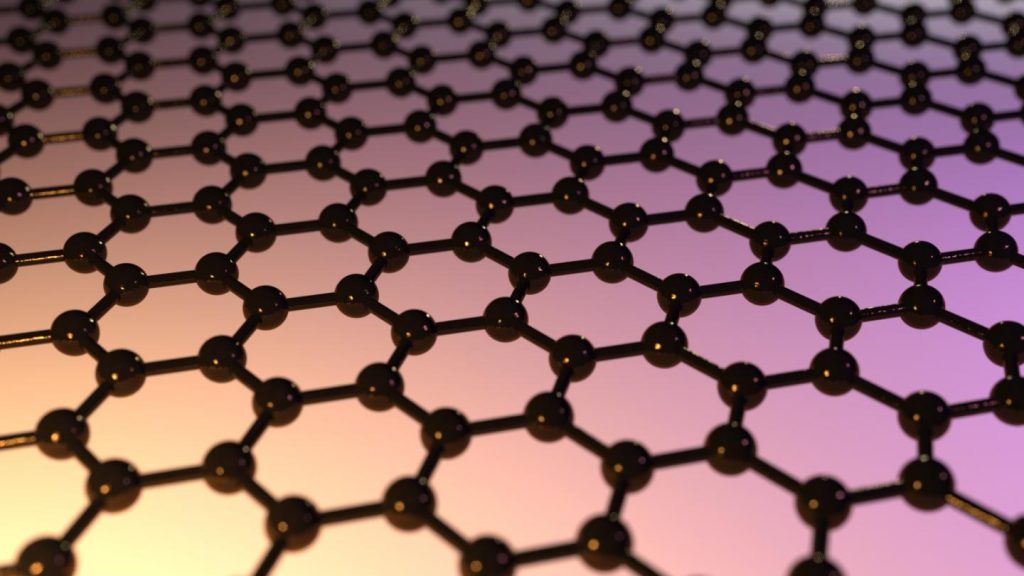I’ve done very little writing about quantum dots (so much nano, so little time) but there’s been a fair amount of activity lately which has piqued my interest. In the last few days researchers at Kansas State University have been getting noticed for being able to control the size and shape of the graphene quantum dots they produce. This one has gotten extensive coverage online including this May 17, 2012 news item on physorg.com,
Vikas Berry, William H. Honstead professor of chemical engineering, has developed a novel process that uses a diamond knife to cleave graphite into graphite nanoblocks, which are precursors for graphene quantum dots. These nanoblocks are then exfoliated to produce ultrasmall sheets of carbon atoms of controlled shape and size.
By controlling the size and shape, the researchers can control graphene’s properties over a wide range for varied applications, such as solar cells, electronics, optical dyes, biomarkers, composites and particulate systems. Their work has been published in Nature Communications and supports the university’s vision to become a top 50 public research university by 2025. The article is available online.
Here’s an image of graphene being cut by a diamond knife from the May 16, 2012 posting by jtorline on the K-State News blog,

Molecular dynamics snapshot of stretched graphene being nanotomed via a diamond knife.
Here’s why standardizing the size is so important,
While other researchers have been able to make quantum dots, Berry’s research team can make quantum dots with a controlled structure in large quantities, which may allow these optically active quantum dots to be used in solar cell and other optoelectronic applications. [emphasis mine]
While all this is happening in Kansas, the Econ0mist magazine published a May 12, 2012 article about some important quantum dot optoelectronic developments in Spain (an excellent description for relative beginners is given and, if this area interests you, I’d suggest reading it in full),
Actually converting the wonders of graphene into products has been tough. But Frank Koppens and his colleagues at the Institute of Photonic Sciences in Barcelona think they have found a way to do so. As they describe in Nature Nanotechnology, they believe graphene can be used to make ultra-sensitive, low-cost photodetectors.
…
A typical photodetector is made of a silicon chip a few millimetres across onto which light is focused by a small lens. Light striking the chip knocks electrons free from some of the silicon atoms, producing a signal that the chip’s electronics convert into a picture or other useful information. …
Silicon photodetectors suffer, though, from a handicap: they are inflexible. Nor are they particularly cheap. And they are not that sensitive. They absorb only 10-20% of the light that falls on to them. For years, therefore, engineers have been on the lookout for a cheap, bendable, sensitive photodetector. …
By itself, graphene is worse than silicon at absorbing light. According to Dr Koppens only 2.7% of the photons falling on it are captured. But he and his colleague Gerasimos Konstantatos have managed to increase this to more than 50% by spraying tiny crystals of lead sulphide onto the surface of the material.
So combining the ability to size quantum dots uniformly with this discovery on how to make graphene more sensitive (and more useful in potential products) with quantum dots suggests some very exciting possibilities including this one mentioned by Dexter Johnson (who’s living in Spain these days) in his May 16, 2012 posting on Nanoclast (on the Institute of Electrical and Electronics Engineers [IEEE] website),
The researchers offer a range of applications for the graphene-and-quantum-dot combination, including digital cameras and sensors. [emphasis mine] But it seems the researchers seem particularly excited about one application in particular. They expect the material will be used for night-vision technologies in automobiles—an application I have never heard trotted out before in relation to nanotech.
You can get more insights, more precise descriptions if you want to follow up from the Econ0mist article, and Dexter’s links to more information about the research in his posting.
In my final roundup piece, I received a news release (dated April 24, 2012) about a quantum dot commercialization project at the University of Utah,
One of the biggest challenges for advancing quantum dots is the manufacturing process. Conventional processes are expensive, require high temperatures and produce low yields. However, researchers at the University of Utah believe they have a solution. They recently formed a startup company called Navillum Nanotechnologies, and their efforts are gaining national attention with help from a team of M.B.A. students from the David Eccles School of Business.
The students recently won first place and $100,000 at the regional CU Cleantech New Venture Challenge. The student competition concluded at the University of Colorado in Boulder on Friday, April 20. The student team advances to the national championship, which will be held in June in Washington, D.C. Student teams from six regions will compete for additional prizes and recognition at the prestigious event. Other regional competitions were held at MIT, Cal Tech, the University of Maryland, Clean Energy Trust (Chicago) and Rice University. All the competitions are financed by the U.S. Department of Energy.
The students will be competing in the national Clean Energy Business Plan Competition taking place June 12-13, 2012 in Washington, D.C. Here are a few more details from the national competition webpage,
Winners of the six regional competitions will represent their home universities and regions as they vie for the honor of presenting the best clean energy business plan before a distinguished panel of expert judges and invited guests from federal agencies, industry, national labs and the venture capital community.
Confirmed Attendees include:
The Honorable Steven Chu
Energy Secretary [US federal government]
Dr. David Danielson
Assistant Secretary, EERE [US Dept. of Energy, energy efficiency and renewable energy technologies)
Dr. Karina Edmonds
Technology Transfer Coordinator [US Dept. of Energy]
Mr. Todd Park
Chief Technology Officer, White House
Good luck to the students!


